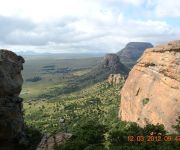Facts and Data
Webpages:
Official Unesco Page
View photos from OUR PLACE the World Heritage collection
Protectedplanet.net
Basis Data:
Unesco World heritage since: 2000
Size of heritage: 249,313 ha
- Buffer zone: 46,630 ha
Coordinates:
Longitude: 29,123°
Latitude: -28,235°
Summary
The Maloti-Drakensberg Park is a transboundary site composed of the uKhahlamba Drakensberg National Park in South Africa and the Sehlathebe National Park in Lesotho. The site has exceptional natural beauty in its soaring basaltic buttresses, incisive dramatic cutbacks, and golden sandstone ramparts as well as visually spectacular sculptured arches, caves, cliffs, pillars and rock pools. The site's diversity of habitats protects a high level of endemic and globally important plants. The site harbors endangered species such as the Cape vulture (Gyps coprotheres) and the bearded vulture (Gypaetus barbatus). Lesotho’s Sehlabathebe National Park also harbors the Maloti minnow (Pseudobarbus quathlambae), a critically endangered fish species only found in this park. This spectacular natural site contains many caves and rock-shelters with the largest and most concentrated group of paintings in Africa south of the Sahara. They represent the spiritual life of the San people, who lived in this area over a period of 4,000 years.
Location on Map
Show bigger map on Openstreetmap
Maloti-Drakensberg Park: A Jewel of Lesotho's Natural Heritage
The Maloti-Drakensberg Park, located in the southeastern region of Lesotho, is a UNESCO World Heritage site that encompasses the majestic Drakensberg mountain range. Spanning an area of approximately 242,813 hectares, this park is a testament to the outstanding natural beauty and rich cultural heritage of the region.
Historical Significance
The history of the Maloti-Drakensberg Park dates back thousands of years, with evidence of human habitation in the area since the Stone Age. The San people, also known as Bushmen, were the first inhabitants of the region and left behind an extraordinary legacy of rock art. These ancient paintings, found in numerous caves and shelters throughout the park, provide invaluable insights into the lives and beliefs of the San people.
During the 19th century, the region became a refuge for the Basotho people, who were fleeing from the conflicts caused by the expansion of European settlers. The Basotho, under the leadership of King Moshoeshoe I, established a stronghold in the mountains, which played a crucial role in preserving their culture and independence.
Current State and Conservation Efforts
The Maloti-Drakensberg Park is renowned for its exceptional biodiversity, with a wide range of ecosystems and species thriving within its boundaries. The park is home to an impressive array of flora and fauna, including over 2,000 plant species, 48 mammal species, and 299 bird species. Notably, it serves as a critical habitat for several endangered species, such as the Cape vulture and the bearded vulture.
Efforts to conserve and protect the park's natural and cultural heritage have been ongoing for several decades. The governments of Lesotho and South Africa, which jointly manage the park, have implemented various measures to ensure its preservation. These include the establishment of protected areas, the enforcement of strict regulations, and the promotion of sustainable tourism practices.
One of the key conservation initiatives in the park is the preservation of the San rock art. These ancient paintings are vulnerable to natural deterioration and human interference. Therefore, extensive efforts have been made to document, study, and safeguard these invaluable cultural treasures. Additionally, educational programs and interpretive centers have been established to raise awareness about the significance of the rock art and the history of the San people.
The Maloti-Drakensberg Park offers visitors a unique opportunity to immerse themselves in the awe-inspiring beauty of the Drakensberg mountains and experience the rich cultural heritage of the region. The park provides a range of recreational activities, including hiking, rock climbing, and wildlife viewing. Moreover, the local communities surrounding the park actively participate in ecotourism initiatives, offering visitors a chance to engage with the local culture and contribute to the sustainable development of the area.
In conclusion, the Maloti-Drakensberg Park stands as a testament to the remarkable natural and cultural heritage of Lesotho. With its breathtaking landscapes, ancient rock art, and diverse ecosystems, this UNESCO World Heritage site continues to captivate and inspire visitors from around the world.


